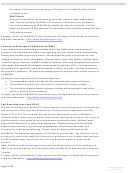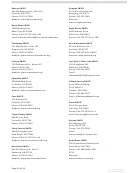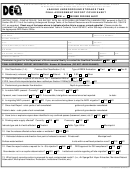Funds And Resources For Drinking Water Source Protection - Department Of Environmental Quality Page 4
ADVERTISEMENT
Projects for reforestation or replanting in sensitive or riparian areas
Installation of fencing to protect sensitive riparian source areas
Installation of signs at boundaries of zones or protection areas
Projects for assessing risks from onsite systems near supply wells,
inspections, pump-outs, or decommissioning onsite systems.
Secondary containment for high-risk ABOVE ground tanks
Focused workshop events for household/business instruction for changing to
alternative nonhazardous product usage (“green chemical” products)
Seismic spill prevention or inspection project in proximate areas for high-risk
sources
Permanent abandonment (i.e. filling in) of inadequately constructed private
wells within the source area
Installation of fencing around the immediate intake or well area to provide
protection
Structures to divert contaminated stormwater runoff affecting the source
area
Set up ecosystem services (or similar) project in watershed to fund
preservation areas
Implementation of pollution prevention or waste reduction projects
Restoration and/or conservation projects within the drinking water source
area
Implementation of water reuse and other conservation measures related to
source protection
Implementation of best management practice projects
Implementation of conservation easements to protect sensitive source areas
Implementation of a drinking water source protection ordinance
Establishing management plans for easements or lands purchased within
source areas
Development of educational flyers/brochures for purposes of public
education
Purchase of lands within the drinking water source area (funded only via low
interest loans)
Any Public and Privately-owned Community and Nonprofit Non-Community water
systems with a completed Source Water Assessment are eligible for funds. A
“community water system” is defined as a public water system that has 15 or more
service connections used by year-round residents, or which regularly serves 25 or
more year-round residents. This includes water systems that are owned privately, by
non-profit or public entities such as a city, district, or port. A “nonprofit non-
community water system” is a public water system that is not a community water
system and that regularly serves at least 25 people (more than 6 months per year)
and is legally recognized under Oregon law as a nonprofit entity.
For the source water protection funds, contact OHA regarding the letter of interest submittal
schedule. Call Oregon OHA Drinking Water Services at 971-673-0422 or go to the OHA
.
website:
or contact IFA at 503-986-0123;
Page 4 of 28
Last Updated 6/2016
By: Sheree Stewart
ADVERTISEMENT
0 votes
Related Articles
Related forms
Related Categories
Parent category: Legal
 1
1 2
2 3
3 4
4 5
5 6
6 7
7 8
8 9
9 10
10 11
11 12
12 13
13 14
14 15
15 16
16 17
17 18
18 19
19 20
20 21
21 22
22 23
23 24
24 25
25 26
26 27
27 28
28








